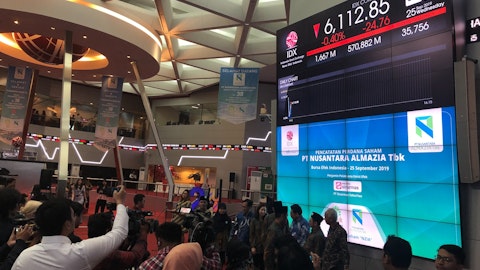Northern Trust Corporation (NASDAQ:NTRS) Q3 2023 Earnings Call Transcript October 18, 2023
Northern Trust Corporation misses on earnings expectations. Reported EPS is $1.49 EPS, expectations were $1.5.
Operator: Good day, and welcome to the Northern Trust Corporation Third Quarter 2023 Earnings Conference Call. Today’s conference is being recorded. At this time, I would like to turn the conference over to Jennifer Childe, Director of Investor Relations. Please go ahead, ma’am.
Jennifer Childe : Thank you, Melissa, and good morning, everyone, and welcome to Northern Trust Corporation’s Third Quarter 2023 Earnings Conference Call. Joining me on our call this morning is Mike O’Grady, our Chairman and CEO; Jason Tyler, our Chief Financial Officer; Lauren Allnutt, our Controller; and Grace Higgins from our Investor Relations team. Our third quarter earnings press release and financial trends report are both available on our website at northerntrust.com. Also on our website, you will find our quarterly earnings review presentation, which we will use to guide today’s conference call. This October 18 call is being webcast live on northerntrust.com. The only authorized rebroadcast of this call is the replay that will be made available on our website through November 18.
Northern Trust disclaims any continuing accuracy of the information provided in this call after today. Please refer to our safe harbor statement regarding forward-looking statements on Page 12 of the accompanying presentation, which will apply to our commentary on this call. During today’s question-and-answer session, please limit your initial query to one question and one related follow-up. This will allow us to move through the queue and enable as many people as possible the opportunity to ask questions as time permits. Thank you again for joining us today. Let me turn the call over to Mike O’Grady.
Michael O’Grady: Thank you, Jennifer. Let me join in welcoming you to our third quarter 2023 earnings call. Our results for the third quarter reflect solid execution against the challenging phase of this interest rate cycle, particularly as rates appear close to be peaking. Third quarter deposit levels were generally in line with seasonal expectations, but funding costs were significantly higher, putting pressure on net interest income. We’re focusing primarily on those areas of the business that are most under our control. Namely trust fees and expenses. In those 2 areas, we’re pleased with our performance. Trust fee revenue was up both sequentially and year-over-year. Expenses were well controlled, and we improved our capital position.
Our Wealth Management business grew trust fees on both a sequential and year-over-year basis. We saw ongoing strength in the higher wealth tiers and within our Global Family Office segment, where momentum outside the U.S. continues to be brisk. Families with large and complex truck structures continue to be an area where we excel. Activity with business owners also remains robust, helping them optimize their complex personal affairs while they attend to growing their businesses is a consistent theme. We’re also seeing early success with various new marketing approaches and referral sources. In particular, during the third quarter, we had healthy new business generation with clients with assets over $50 million. In Asset Management, we saw positive flows into our institutional money market platform for the third consecutive quarter.
Relative to benchmarks, our tax-advantaged equity product performance remained strong within the quarter cementing its 1, 3 and 5-year track record of out-performance. Importantly, 2 recent large asset servicing wins contain asset management mandates for index fixed income and outsourced investment solutions. Reinforcing our combined strength as One Northern. Within Asset Servicing, we had good momentum in core custody and fund administration and our pipeline remains solidly within historical levels. Our front office solutions is resonating particularly well across regions and different client types. One notable front office solutions win in the third quarter was the $32 billion Abu Dhabi Pension Fund. Our ability to provide a comprehensive view across public and private assets was cited as a key differentiator.
Importantly, we were also selected to provide global custody, liquidity management, performance in risk analytics and portfolio optimization. We also had good success in the U.S. asset owner space where we continue to take share. In closing, we entered the fourth quarter on solid footing. Our balance sheet continues to be very strong with ample capital and liquidity, and our credit quality remains excellent. New business momentum is healthy and our pipeline is robust. Expense growth has declined each quarter this year, and I’m confident that we’ll continue to build on this discipline. We’re well positioned to navigate the current uncertain environment including the proposed regulatory changes related to capital and long-term debt and generate value for our stakeholders.
I’ll now turn the call over to Jason.
Jason Tyler : Thank you, Mike, and let me join Jennifer and Mike in welcoming you to our third quarter 2023 earnings call. Let’s dive into the financial results of the quarter, starting on Page 4. This morning, we reported third quarter net income of $328 million. Earnings per share of $1.49, and our return on average common equity was 11.6%. Our assets under custody/administration and assets under management were down modestly on a sequential basis but up sharply on a year-over-year basis. Unfavorable markets and currency movements more than offset positive asset inflows relative to the prior period. Year-over-year levels benefited from favorable markets, currency improvements and asset inflows. On a year-over-year basis, currency movements had an approximate 90 basis point favorable impact on revenue growth, largely within our Asset Services division and a 100 basis point unfavorable impact on expenses.
On a sequential basis, currency impacts were immaterial. Excluding notable items in all periods, revenue was down 2% on both a sequential quarter and year-over-year basis. Expenses were up 1% sequentially and up 5% over the prior year. This reflects an expense to trust fee ratio of 115%, down from 116% in the second quarter but higher than the 112% we posted in the third quarter of last year. Pre-tax income was up 1% sequentially, but down 20% over the prior year. Trust, investment and other servicing fees, representing the largest component of our revenue, totaled $1.1 billion, a 1% sequential increase and a 3% increase compared to last year. All other noninterest income was up 6% sequentially, but down 3% over the prior year. Net interest income on an FTE basis was $469 million.

A successful investor smiling confidently, looking over a stock market report.
Down 10% sequentially and down 11% from a year ago. Our provision for credit losses was $14 million in the third quarter. Overall, our credit quality remains very strong. We had small net recoveries for the quarter, and there was a modest increase in nonperforming loans. Turning to our asset servicing results on Page 5. Assets under custody and administration for asset servicing clients were $13.2 trillion at quarter end, down 2% sequentially but up 10% year-over-year. Asset servicing fees totaled $626 million. Custody and fund administration fees, the largest component of fees in the business were $428 million. Sequential performance reflects favorable markets and new business activity, offset by weaker transaction volume. The year-over-year strength was due to solid new business activity and favorable market and currency impacts.
That were partially offset by lower transaction volume. Assets under management for asset servicing clients were $963 billion, down 3% sequentially, but up 10% year-over-year. Similarly, because a significant portion of our fees are billed on a lagged basis, the sequential decline in AUM will impact our fourth quarter trust fees. Investment management fees within asset servicing were $137 million. Moving to our Wealth Management business on Page 6. Assets under management for our wealth management clients were $370 billion. Trust administration and other servicing fees for wealth management clients were $486 million. Our average balance sheet decreased 4% on a linked quarter basis, primarily due to lower client deposits. Client liquidity was essentially flat during third quarter.
Average deposits were $102 billion, down $4 billion or 4% sequentially, in line with our expectations for this seasonably weaker quarter. The decline was seen largely in the interest-bearing channel as clients continue to reallocate cash position. Noninterest-bearing deposits remained stable, down less than $1 billion sequentially, and the mix held steady at 17%. At quarter end, operational deposits remained at approximately 2/3 of institutional deposits and institutional deposits comprised 75% to 80% of the total mix. Shifting to the asset side of the balance sheet. The duration of the securities portfolio reduced slightly to 1.9 years. The total balance sheet duration continues to be less than a year. Loan balances averaged $42 billion and were flat sequentially.
Our loan portfolio is well diversified across geographies, operating segments and loan types. Approximately 70% of the loan portfolio is floating and the overall duration is below one year. Our liquidity remains strong. Cash held at the Fed and other central banks was down reflecting the absorption of the deposit decreases, but highly liquid assets comprise more than 55% of our deposits and nearly 50% of total earning assets. Net interest income on an FTE basis was $469 million for the quarter, down 10% sequentially and down 11% from the prior year. NII reflected the impact of several dynamics. We saw some continued client migration into higher-yielding cash alternatives, but the pace moderated as we expected. Deposit cost increases were a slightly bigger factor with funding costs up 46 basis points over the second quarter.
Due to the competitive environment, we repriced a small number of meaningful products to ensure we’re protecting deposit volumes. We’re not price leaders, but we’re vigorously defending our deposits with an eye toward playing the long game. We expect to benefit from this strategy when rates decline. Client engagement also led to a combination of specific repricing on existing accounts and a shift to higher paying term deposits. There’s no question that clients want to remain on our balance sheet. But sensing that the rate cycle is close to peaking. They’ve begun to stretch for duration. Our NII in the fourth quarter will continue to be driven by client behavior, which has been less predictable given the speed and extent of this cycle’s rate hikes.
Our average client deposits thus far in the quarter are $100 billion. Modest outflows are expected to continue, due in part to client efforts to optimize returns and to some known outflows related to M&A activity and other corporate needs. Pricing should remain under pressure with further NIM compression possible. We currently expect fourth quarter NII to be in the range of $430 million to $440 million. Factors that could swing the outcome include the pace of further deposit outflows, the level of price pressure, the extent to which we see — we continue to see deposit mix shift and the offsetting impact from the repricing of the securities portfolio. As we look out to 2024, there are a wide range of scenarios under which net interest income could trend.
Deposit pricing pressure, our securities maturity schedule, investment outlook and other factors provide upside that’s not reflected in the current quarter. Turning to Page 8. As reported, noninterest expenses were $1.3 billion in the third quarter, down 4% sequentially but up 4% as compared to the prior year. Excluding unusual items in both periods, including those noted on the slide, expenses in the third quarter were up 1% sequentially and up over 5% year-over-year. I’ll hit on just a few highlights. Excluding unusual items, compensation expense was down 2% sequentially. This reflected reductions in incentive compensation and head count actions taken year-to-date. The increase over the last year reflects 2023 base pay adjustments. Excluding unusual items in all periods, non-compensation expense was up 3% sequentially.
Our expense-to-trust fee ratio improved 100 basis points sequentially to 115%, but remains higher than our targeted range of 105% to 110%. As a reminder, we began the year expecting to take at least 200 basis points off of our 2022 adjusted expense growth rate of 9%. Our first quarter adjusted results were meaningfully better, up 5.8% year-over-year. Our second quarter adjusted results were even better up 5.3% year-over-year. And our third quarter results were in the same range despite unfavorable currency impacts. For the fourth quarter, we expect continued improvement. Compensation expense is expected to be up $5 million. Benefits expense should be our normal fourth quarter lift of $3 million to $5 million. Outside services likely to be up approximately $10 million.
Equipment and software should be up approximately $10 million relative to adjusted third quarter levels. And occupancy is expected to increase a few million dollars above adjusted third quarter levels. Other operating expense has many components, including market-driven categories that are not predictable, but it has tended to increase in the fourth quarter. All in, this would put our full year adjusted expense growth rate at approximately 5% or roughly 400 basis points lower than 2022 levels. Our financial model is based upon mid-single-digit trustee growth from a combination of organic growth and market appreciation. Against this backdrop, we hope to generate 100 to 200 basis points in trust fee operating leverage in normal macro environments.
Our capital levels and ratios remained strong in the quarter. We continue to operate at levels well above our required regulatory minimum. Our common equity Tier 1 ratio under the standardized approach was up slightly from the prior quarter to 11.4% as capital accretion more than offset the unfavorable impact from higher rates on our securities portfolio. This reflects a 440 basis point buffer above our regulatory requirements. Our Tier 1 leverage ratio was 7.9%, up 50 basis points from the prior quarter. At quarter end, our AOCI was a negative $1.4 billion, a slight improvement over second quarter levels. We returned $159 million to common shareholders through cash dividends of $158 million and common stock repurchases of $1 million. We slowed our buyback activity in order to reserve for the anticipated FDIC special assessment.
We’re well positioned to meet the proposed regulatory requirements, that Mike referenced without significant changes to our operating model. And with that, Melissa, please open the line for questions.
See also 20 Most Innovative States in the US and 16 Best Investing Podcasts in 2023.
Q&A Session
Follow Northern Trust Corp (NASDAQ:NTRS)
Follow Northern Trust Corp (NASDAQ:NTRS)
Operator: [Operator Instructions] And we can go with our first question from Glenn Schorr with Evercore.
Glenn Schorr : That was like the price is right. I like it. Okay. So I appreciate the range of outcomes for NII next year that you can control. So I’ll leave that aside for a second. But you mentioned your expense-to-trust fee ratio, your target and what you can do in terms of operating leverage in a better environment or normalize. I’m curious just what’s the overall approach towards expenses as you enter budget season next year within that mindset of what your goals are? And how do you approach it with that much uncertainty around things that you can’t control?
Jason Tyler: Yes. Well, as we enter, this is the time of year where we’re thinking — trying to get a sense of where the launch points will be. And I walked through a little bit of a financial model for you guys to think about. That if we’re — over time, we’ll get lift from the equity markets and we should also have low to mid-single-digit organic growth. If we can get 100 to 200 basis points in fee operating leverage, that sets us up really well based on where our pretax margin is for good EPS growth over time. And so that’s the goal that we — it’s one of the metrics that we look at really closely. And we’re still in an inflationary environment where it’s harder to get that that operating leverage if you’re just looking at fees because the expenses are elevated and you don’t get the benefit from higher rates on the trust fee line.
But you can tell that we’ve spent an incredible amount of effort this year working the year-over-year expense growth rates down. And you go back to 2022 and printing a 9% growth. Coming into this year, we knew we had to do better than that, and we’ve been grinding that down each quarter, quarter after quarter. We first tackled it with working hard on labor. And you can see that’s the biggest cost that we have. So we have to get that right. Headcount is down, and then another key element is technology. That shows up in equipment, software and outside services. That’s still elevated above the rest of the company in terms of growth rate, but we’ve had a lot of accomplishments there, too. and expecting to have that growth rate be lower next year than it has historically.
And so we think we can have another year next year that’s similar to what we did in this year, which is to work that — could continue to work that year-over-year growth rate down.
Glenn Schorr : Exactly what I look for. You have tons of capital and you generate plenty also. But I’m curious, some of the big banks have articulated what they thought as is the RWA impact or all-in impact might be. I’m curious at your first glance — what type of impact are we talking? I know that you mentioned it doesn’t disrupt your model, and I agree. I’m just curious if you can help us box it in, in terms of [indiscernible] impact, if as is?
Jason Tyler: Sure. Yes, I’m going to give you a wide range of like 5% to 15% in RWA, and that will — that’s going to be impacted by a few different things. But one of the benefits that we have is the diversification of the business model. And so we’ve got — obviously, the custody business comes with a lot of operational risk. That’s really the most significant driver but we’ll actually get some benefit from an RWA perspective in some of the loan treatments. Just given the nature of our underlying loans. And then there are some other dynamics that we have that should help on RWA as well on a relative basis. But it’s — we’re thinking about it at this point, it could be anywhere from 5% to 15%. As we mentioned earlier, we feel really comfortable, and we see where our CET1 levels are and see where our liquidity is.




